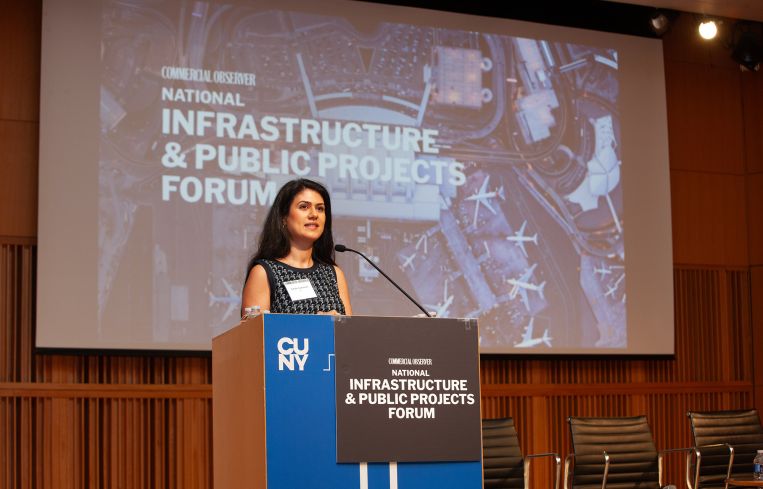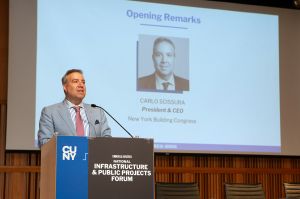How Public-Private Partnerships Drive New York City’s Big Projects
A recent Commercial Observer forum focused on heavy lifts such as the Port Authority Bus Terminal redevelopment and expanding John F. Kennedy Airport
By Amanda Schiavo June 13, 2025 10:52 am
reprints
Partnership, resilience and support were just a few of the themes at Commercial Observer’s Infrastructure and Public Projects Forum, held June 11 at City University of New York’s Graduate Center Recital Hall.
Hosted by Natalie Sachmechi, an associate in the nonprofit education and government practice at JLL, the forum brought together experts from across New York City for discussions on critical design and construction projects that are reshaping the five boroughs through public-private partnerships.
“These partnerships are the heartbeat of our city, and they’re the heartbeat of New York’s transformation,” Sachmechi said as she opened the event. “When you think about public-private partnerships, think about beautiful new airport terminals, the development of One Vanderbilt, the new Grand Central Station, Long Island Rail Road, the renovation of Penn Station, the High Line, Hudson River Park — all of these things.”
Panelists at the forum discussed newer projects than what Sachemic listed, including the revamp of terminals and other parts of John F. Kennedy International Airport, the planned Port Authority Bus Terminal, the progress of some all-electric buildings throughout the city and more. These projects are the envy of other cities, according to Carlo Scissura, president and CEO of the New York Business Congress.
“I was talking to a friend of mine — I won’t mention which city she lives in — but she said, ‘We just want one of your projects, just one would transform our city’,” Scissura said. “When you are thinking about the things that are happening … it’s a moment in our history that is transformative.”
The JFK and Port Authority projects took center stage at the forum. But before the different panelists covered those projects, Brian Gardner, chair of the construction services department at Cole Schotz, introduced Thomas Foley, commissioner of the city’s Department of Design and Construction, to talk about some smaller projects from around the city.
These projects include the Orchard Beach Maintenance and Operations Building in the Bronx, and the Shirley Chisholm Recreational Center in Brooklyn, which features a swimming pool that was designed and constructed by the same team that did the swimming pools for the last Olympic Games in Paris.

Following Foley’s remarks, a panel came together to discuss the JFK and Port Authority projects. The speakers were Omar Alrawi, project director of New York Aviation Group; Justin Ginsburgh, managing director of infrastructure properties and development at JetBlue; Maria Martinson, executive vice president at AECOM Tishman; Jacquelene McCarthy, director of aviation redevelopment at the Port Authority of New York and New Jersey; Palmina Whelan, capital program director at the new Terminal One at JFK; and Sharon Novak, president and CEO of electrical contractor Electra USA.
The Terminal One project at JFK is part of the Port Authority’s $19 billion undertaking to revamp the airport, which Novak called “the entrance into the city.” It takes a lot of collaboration between public and private entities to get an undertaking of this magnitude off the ground — pun intended.
“The relationship between the Port Authority as a private entity and our airline partners, our private developers, et cetera, is a complex one,” McCarthy said. “We need to make sure our expectations between [all] groups are clearly communicated throughout that process. That means having recurring meetings making sure that there’s our [public works] or that there’s performance criteria that’s clearly understood by both parties.”
It is expected that the Terminal One project will be completed by 2030 and be the largest terminal at the airport, with 23 gates and more than 300,000 square feet of retail. But JFK isn’t the only Triple P project the Port Authority is working on.
The Midtown bus terminal — described in its current condition by Gov. Kathy Hochul as a “hellhole” — is undergoing a $10 billion revamp that will accommodate larger buses and a greater number of them, and make the entire facility more accessible and aesthetically pleasing.
“The current bus terminal is kind of like a fortress, trying to keep the invading armies of I don’t know who out, but it’s not welcoming, and it’s not attractive to the local residents,” Hersh Parekh, deputy chief of intergovernmental affairs for the Port Authority, said during a fireside chat with Sheila Pozon, partner with Herbert Smith Freehills Kramer. “So we’re also going to be looking to make this terminal meet the needs of the community.”
(Pozon also moderated a chat with Jamie Torres-Springer, president of Metropolitan Transportation Authority Construction & Development.)
The inclusion of minority- and women-owned businesses (MWBE) on these and other projects was another key theme of the forum, another facet of the public-private partnerships that city government can help enhance.
“I’ve worked for some great leaders,” said Michael Garner, chief business diversity officer for the Mayor’s Office of Minority and Women-Owned Business Enterprises. “All of them have a commonality, and that is making sure that city and state contracts are awarded in a way that’s inclusive, but give MWBEs the support services that they need in order to create an environment that’s conducive to their recruitment and their growth.”
Research shows that a diverse pool of collaborators brings together unique perspectives to enhance development.

The forum also featured a panel on how public-private partnerships can collaborate to improve the dreary affordable housing situation in New York City. The speakers were Jonathan Gouveia, chief real estate officer and executive vice president for the New York City Housing Authority (NYCHA); Rick Gropper, co-founder and principal of Camber Property Group; Michael Kornspun, managing director of development for Fairstead; Richard Roberts, principal and chief business development officer for Red Stone Equity Partners; Matthew Rooney, principal and CEO with MDG Design & Construction; and Ashley Dinardo, senior principal at Cozen O’Connor.
The discussion focused on leveraging public-private partnerships to develop affordable housing in New York City. By now, New York’s long-standing housing crisis is widely known, but finding a solution is an enduring challenge. Still, each of the panelists’ organizations is working toward creating more affordable housing options across the city, particularly through public- private partnerships.
“NYCHA has historically been looked at as this problem for the city, that certain administrations didn’t want to touch it at all,” Rooney said. “Some people say, ‘Oh, we’ll just throw dollars at it to try to solve the issue.’ But [we have to look] at NYCHA as more of an asset to the city. There is no other source in the city of land that could be used — not even just for housing, but for solving a lot of the other issues that the city is looking at.”
Designing new homes — whether they are affordable or market-rate — requires considerable thought regarding the buildings’ sustainability elements.
And that was exactly the focus of one of the forum’s panels, whose speakers included Robert Goodwin, design principal at Perkins & Will; David McCarthy, vice president with Alloy Development; Michael Reed, director of building transformation at the New York State Research and Development Authority; Jeff Rios, senior vice president at engineering firm WSP; Jessica Waldorf, director of policy implementation for the New York State Department of Public Service; and Kelly Westby, managing director of building operations, decarbonization and efficiency at energy consultancy Steven Winter Associates.
The panelists discussed the current and the future state of all-electric buildings in New York, the financing of these projects, as well as the need for holistic collaboration between architects and engineers and the challenges of integrating new systems into existing buildings.
The day wrapped up with two separate discussions on how the New York City waterfront has been evolving. Cole Schotz’s Gardner returned to the stage to chat with Melissa Burch, executive vice president and chief operating officer for the New York City Economic Development Corporation about the EDC’s efforts to revitalize New York’s waterfront, particularly the Brooklyn Marine Terminal.
“Many folks know New York City for its iconic skyline. I would say our waterfront is equally iconic and maybe less appreciated and understood, but we are a coastal waterfront city of 520 miles of waterfront … more than some of the [country’s] most acclaimed coastal cities,” Burch said. “This is a huge asset for our city.”

Burch’s commentary was the perfect segue into the last panel of the day, which also focused on waterfront revitalization. The speakers were Nate Grove, chief of waterfront and marine operations for the New York City Department of Parks and Recreation; Shari Hyman, vice president and chief strategic relationship manager for Turner Construction; Kimberlae Saul, vice president of planning and design for the Battery Park City Authority; and Aislinn McGuire, managing director for the Contractors’ Association of Greater New York.
The discussion focused on the revitalization of the waterfront, environmental protection, and creating space for recreation and commerce, as well as on the importance of public-private partnerships and stakeholder engagement. It brought the event home with those same themes from earlier in the day of resilience and partnership.
“In the past several years, we’ve definitely seen a concerted effort and focus on revitalizing and developing the waterfront,” McGuire said, “and balancing the goals of environmental protection, resilience and development, and navigating the myriad federal, state and city agencies that are involved in these processes and marketing.”
Amanda Schiavo can be reached at aschiavo@commercialobserver.com.



